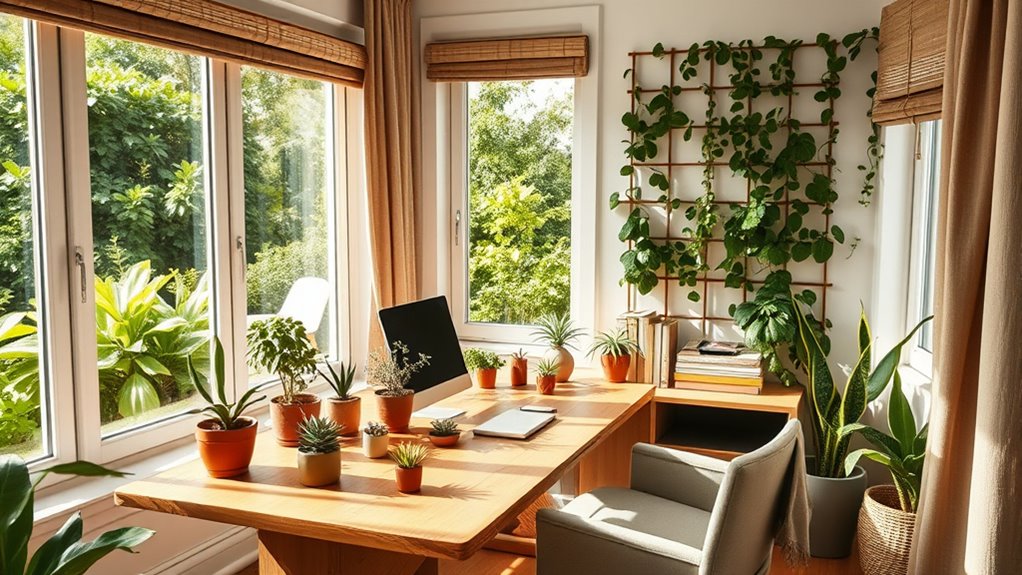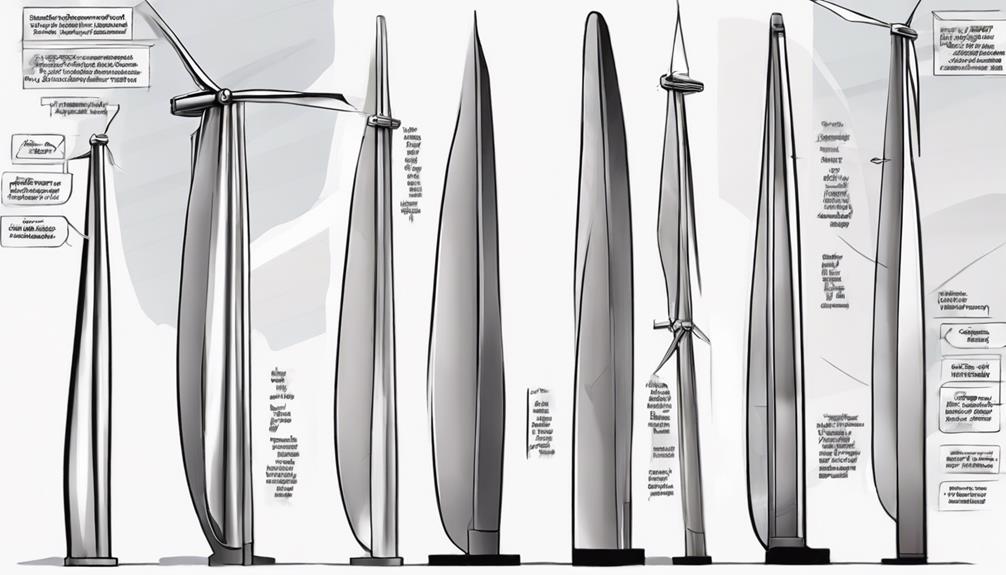To green your workspace, start by choosing sustainable materials like reclaimed wood or bamboo for your furniture. Use energy-efficient lighting, such as LEDs, and maximize natural light. Incorporate eco-friendly accessories like recycled paper and add plants for better air quality. Reduce electronic waste by recycling outdated gadgets and unplugging devices when not in use. Adopting small, consistent sustainable habits will help you create a healthier, more eco-conscious home office—discover more tips to make your space truly green.
Key Takeaways
- Use sustainable desk materials like reclaimed wood or bamboo to reduce resource consumption.
- Maximize natural light and switch to energy-efficient LED lighting to lower electricity use.
- Incorporate eco-friendly office accessories and indoor plants to improve air quality and workspace aesthetics.
- Choose energy-efficient appliances, recycle electronics properly, and unplug devices when not in use.
- Cultivate a green mindset by adopting sustainable habits and integrating eco-conscious practices into daily routines.

Have you ever considered how your home office can be both productive and eco-friendly? Making small changes can create a workspace that’s better for the planet and more inspiring for you. Starting with your desk, opting for sustainable desk materials makes a significant difference. Instead of traditional wood or plastic, look for desks made from reclaimed wood, bamboo, or recycled materials. These options reduce the demand for virgin resources and cut down on waste. Bamboo, in particular, is a fast-growing, renewable resource that offers durability and style. By choosing sustainable materials, you’re supporting environmentally conscious manufacturing practices and reducing your carbon footprint.
Next, consider your lighting setup. Energy-efficient lighting isn’t just about saving electricity; it also enhances your workspace. Switch out incandescent bulbs for LED or CFL bulbs, which consume a fraction of the energy and last much longer. Position your desk near a window to maximize natural light during the day, which not only cuts down on energy use but also boosts your mood and productivity. When artificial lighting is necessary, opt for fixtures with adjustable brightness or task lighting to avoid unnecessary energy consumption. Using smart lighting controls, like timers or motion sensors, ensures lights are only on when needed, further reducing waste.
Beyond your desk and lighting, think about the materials surrounding your workspace. Choose eco-friendly office accessories such as recycled paper, biodegradable pens, and non-toxic cleaning products. These small details contribute to a healthier environment and workspace. Additionally, incorporating plants not only enhances the aesthetic but also improves air quality. Plants like pothos, snake plants, or succulents are easy to care for and require minimal resources, making them ideal for a home office.
Another way to green your home office is by reducing electronic waste. Invest in energy-efficient appliances and electronics, and be sure to recycle or donate old devices properly. Unplug chargers, printers, or other gadgets when not in use to prevent phantom energy drain. When shopping for furniture or office supplies, look for products with eco-labels or certifications, such as FSC or Green Guard, which ensure environmentally responsible manufacturing. Developing a growth mindset can also help you stay motivated to implement sustainable practices consistently.
Creating an eco-friendly home office doesn’t mean sacrificing style or productivity. With thoughtful choices—like sustainable desk materials, energy-efficient lighting, eco-friendly accessories, and mindful electronics use—you can craft a workspace that’s as kind to the planet as it is inspiring for your workday. Every small step adds up, making your home office a model of sustainability and efficiency.
Frequently Asked Questions
How Can I Reduce Energy Consumption in My Home Office?
To reduce energy consumption in your home office, you should follow some simple energy-saving tips. Use power management settings on your devices to automatically turn off or sleep when idle. Switch to energy-efficient lighting, like LEDs, and unplug electronics when not in use. Regularly maintain your equipment to guarantee maximum performance. These steps help cut down on unnecessary energy use, saving you money and reducing your carbon footprint.
What Eco-Friendly Materials Are Best for Office Furniture?
They say, “You are what you surround yourself with,” so choosing eco-friendly materials matters. For your office furniture, opt for recycled wood or bamboo furniture—both sustainable and durable. Recycled wood reduces waste, while bamboo grows quickly and absorbs carbon efficiently. These materials not only help the environment but also create a healthier workspace. Make mindful choices, and you’ll build a greener, more sustainable home office.
How Do I Dispose of Electronic Waste Responsibly?
When it comes to disposing of electronic waste responsibly, you should prioritize e waste recycling programs in your area. Look for certified e waste recycling centers that guarantee responsible disposal of electronics. Don’t just throw e-waste in the trash, as it can harm the environment. Instead, drop off old devices at designated facilities or participate in local collection events. Responsible disposal helps protect the planet and keeps hazardous materials out of landfills.
Are There Sustainable Options for Office Lighting?
You can choose sustainable office lighting by switching to LED bulbs, which use less energy and last longer. Consider solar lighting options for your workspace, like solar-powered desk lamps or outdoor lights, to reduce electricity consumption. These choices are eco-friendly, cost-effective, and help lower your carbon footprint. By making these switches, you create a greener, more sustainable work environment that benefits both the planet and your wallet.
How Can I Improve Indoor Air Quality Naturally?
To improve your indoor air quality naturally, consider adding air purifying plants like snake plants or pothos, which filter toxins and boost oxygen. Make certain proper natural ventilation by opening windows regularly, especially when working in a home office. Using fans or vents can also enhance airflow. These simple steps help create a healthier, fresher environment, making your workspace more comfortable and eco-friendly.
Conclusion
Creating an eco-friendly home office is like planting a seed—you nurture it with mindful choices, and over time, it blooms into a healthier, more sustainable space. I once switched to energy-efficient lighting and noticed my energy bill dropped, and I felt better knowing I was helping the planet. Just as a small seed grows into a mighty tree, your small eco-friendly steps can lead to a greener, more inspiring workspace for years to come.










